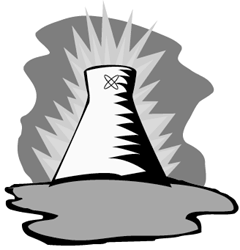Zapped!
Prop. 9: Election decides fate
By Juliane Poirier
JOHN GARN of Graton is miffed--that's why he's voting yes on Proposition 9. "I'm not going to keep bailing out PG&E's stockholders," says Garn. "If they invested in nukes when everyone says it was bad, why shouldn't they have to pay?" Garn, 41, was a Sonoma State University activist in the early 1980s who joined thousands of demonstrators protesting nuclear power at the PG&E Diablo Canyon nuclear facility--a controversial project estimated at $850 million but that ended up costing $5.5 billion, including construction errors of which one alone cost $100 million to correct.
Those costs were passed along to ratepayers, which is one of the reasons why Californians pay more than the national average for their electric power. It's also one of the reasons that consumers were able to get their initiative on the Nov. 3 ballot.
What Prop. 9 offers to ratepayers like Garn and his wife, Shari--who protested construction of the San Onofre nuclear power plant--is the opportunity to stop paying for uneconomical (and what the Garns believe are hazardous and unethical) nuclear investments, along with other utility debts now collected as so-called competition transition charges, also called stranded costs.
Prop. 9 also provides for a 20 percent utility rate drop, effective immediately. Although the utility-funded campaign against Prop. 9 claims that rates will go up, an independent analysis by the California Energy Commission estimates that if the initiative passes, rates would drop as much as 32 percent.
Still, public opinion polls show voters oppose Prop. 9 by a 2-to-1 ratio, though 36 percent remain undecided.
A top PG&E executive would not go on record for this article, but is referring reporters to the No on 9 campaign, of which 99 percent is funded by the utility monopolies. One critic suggested that PG&E won't directly associate with No on 9 because of the negative public image the utility has in Northern California. Other groups are representing the utility's interests in the campaign. Whatever the reason, the No on 9 campaign is outspending proponents of the ballot initiative by a 30-to-1 margin. No on 9 campaign funds came from the three investor-owned monopolies: PG&E gave $13.6 million; Edison International, $13.2 million; and San Diego Gas & Electric and parent company Sempra Energy, $2.9 million.
Indeed, No on 9 campaign money has found its way into the pockets of some unusual backers. Recipients of utility funds include consumer advocate David Horowitz's Fight Back Inc., which received $106,000; the California Chamber of Commerce, which received $27,000 (in addition to over $500,000 received last year from the three utilities); and Jerry Merel's Planning and Conservation League, which received $70,000 for the Prop. 7 campaign--now called "Yes on 7, No on 9" Perhaps most incriminating of all is $39,000 paid to a film production company owned by state Sen. Steve Peace, R-San Diego, who was instrumental in securing passage of AB 1890, the legislation that is now being challenged by Prop. 9.
While AB 1890 protected the interests of large power users and the three investor-owned utilities, legislators dispatched their civic obligations with: a public "education" program, which turned out to be more like a complacency campaign, promoting a confusing message about deregulation (the $73.5 million contract went without bid process to a Los Angeles advertising firm with reported ties to Gov. Pete Wilson); and a 10 percent rate cut funded by bonds that ratepayers were forced to finance. After the bonds are finally paid off in 2008, the actual rate reduction amounts to somewhere between 1.5 and 2.5 percent.
The No on 9 campaign claims that, should Prop. 9 pass, financial responsibility for the rate-reduction bonds will fall to taxpayers rather than investors; but Metropolitan West, the consulting firm that claimed this outcome, earned $103,974 from the utilities.
Bill Dumbrowski, president of the California Retailers Association, represents a segment of the large energy users opposed to Prop. 9. He does not agree with Prop. 9 proponents who describe the utilities' stranded-cost collections as a form of "corporate welfare." Neither does he consider it unfair that small ratepayers should be responsible for utility debt, even for nuclear power.
"That [idea of corporate welfare] is totally ridiculous," says Dumbrowski. "All the nuclear plants were approved by the PUC."
He explains that if AB 1890 hadn't come to pass, we would have simply "kept on paying for [nuclear plants]." Dumbrowski sees AB 1890 as allowing an accelerated collection of charges that "gives us a date when [stranded costs] will go away." That date is 2002. Afterwards, opponents of Prop. 9 hope for a 30 to 40 percent rate drop, from a deregulated marketplace.
But many Californians are wary of making the marketplace a substitute for the democratic process. Harry Snyder, senior advocate of the Consumers Union in San Francisco, sees Prop. 9 as a means of putting the Legislature back into the service of the average Californian. "There's a larger purpose to this initiative," says Snyder. "To give this message to the legislators: You're not going to stick anyone's hand into my pocket."
John Garn thinks there's yet another purpose. "All that's being reported is how long lawsuits could take, and whether we'll lose money, like that's the biggest issue," he says. "If you peel off the cover and really look at it, [Prop. 9] is about people taking back their own power."
[ Sonoma County | MetroActive Central | Archives ]
Copyright © Metro Publishing Inc. Maintained by Boulevards New Media.
![]()

of electrons, equity
From the October 22-28, 1998 issue of the Sonoma County Independent.
![[MetroActive News&Issues]](/gifs/news468.gif)